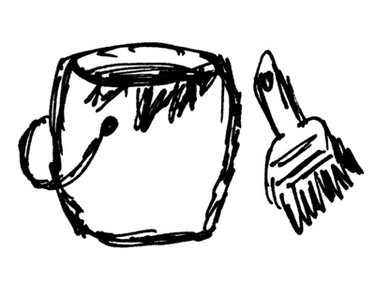Things You'll Need
Primer
Paint
Nylon brushes
Rollers
Paint roller
Scraper

Latex primer and acrylic paint go hand in hand when painting a variety of surfaces - from wood to wallboard, from concrete to metal. Latex primers prepare and promote adhesion of acrylic paint, which in turn provides an elastic surface meant to weather the toughest elements. With both the primer and paint being made with water, this means a quicker drying time and easy (not to mention fast) cleanup with soap and water.
Prepare various surfaces
Step 1
Sand new or weathered wood with fine to medium grit sandpaper, opening the wood grain to receive the primer. Use a power washer for large areas such as a deck, using a deck cleaner as a sanding substitute. Fill gaps in wood with wood filler and then sand.
Video of the Day
Step 2
Before priming, wipe down the surface (drywall, plaster, concrete, steel, etc.) with a moist rag or a household cleaning solution, remembering you want the primer to stick to the surface, not the grime. Clean water stains off of walls and ceilings with a solution of bleach and water to kill mildew. Allow all surfaces to dry thoroughly.
Step 3
Scrape any loose paint from previously painted concrete, wood, steel, plaster or drywall to ensure the primer will stick to a sound surface, not peeling paint. Use a paint scraper for this job or power washer for large areas, carefully adjusting the setting to prevent damage to the surface.
Choose the primer, paint
Step 1
Choose a latex primer intended for unpainted wood, which allows moisture to breathe through the paint rather than trapping it inside, preventing bubbling and peeling. Latex wood primer also binds wood fibers on weathered, unpainted wood, stabilizing the surface for an acrylic top coat, which remains elastic during temperature changes.
Step 2
Choose a latex primer intended for concrete walls, often referred to as block filler. Block filler is purposefully thick to fill the porous holes in concrete to prevent moisture from entering and causing paint failure. Using block filler will ensure that you use less paint when applying your acrylic top coat.
Step 3
Choose a latex primer, often known as drywall sealer, for new drywall to soak in and seal the wall. This "sealing" of the wall will allow the acrylic topcoat to be applied in a uniform manner, preventing dark spots.
Step 4
Choose a latex primer for steel only if it's for direct-to-metal application and if there is no rust on the surface. The latex primer will promote adhesion of an acrylic topcoat, which will in turn provide a durable, elastic finish thanks to its chemical-base, which will allow maximum exposure to exterior conditions.
Apply primer, paint
Step 1
Spray, roll or brush the primer first, knowing spraying and rolling leave the fewest marks. Latex primers are thinned with water, and the manufacturer's label should be consulted as to how much to use to promote a more uniform finish. Use nylon brushes for acrylic latex paint and primers.
Step 2
Spray, roll or brush the paint after the primer has dried, which is typically within an hour, though always consult the manufacturer's label. A rule of thumb is four hours between a first and second top coat.
Step 3
Wait 24 hours before putting any surface into service and at least 30 days before using any household cleaners on it. Typically it takes 30 days for paint to cure, though acrylic paints often dry to the touch in 45 minutes.
Tip
Tinting latex primers can save you time by cutting down on how many top coats of acrylic paint are needed to finish the job. Tinting a latex primer is recommended if the top coat is a darker color. Always tint the primer coat with half the formula of the top coat, sometimes even less.
Video of the Day